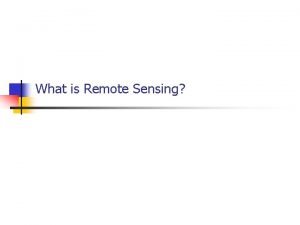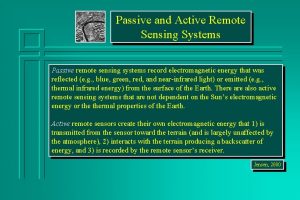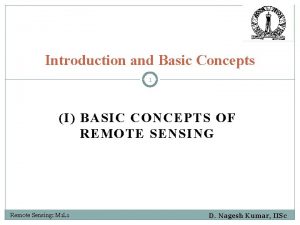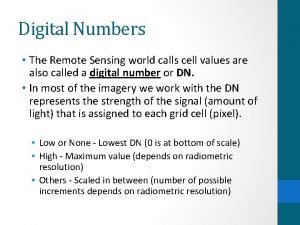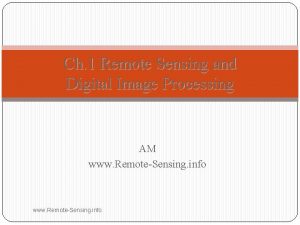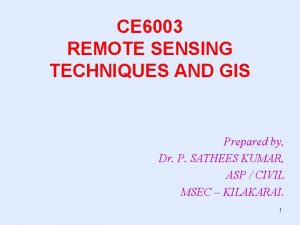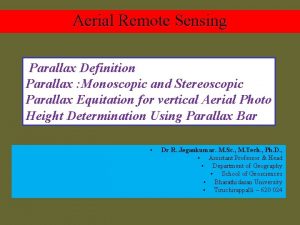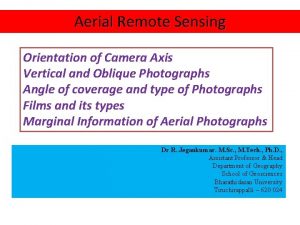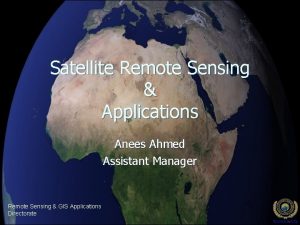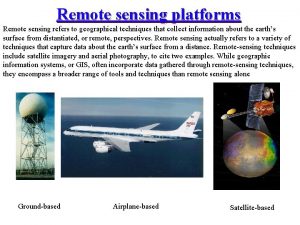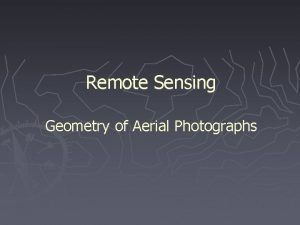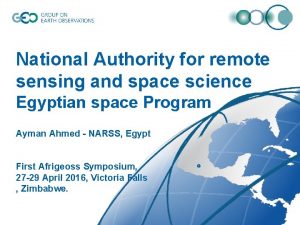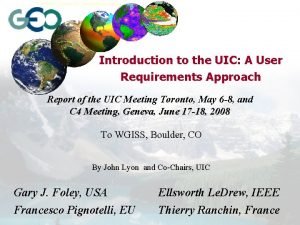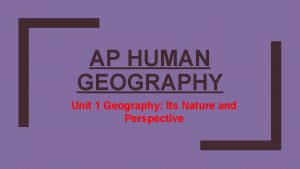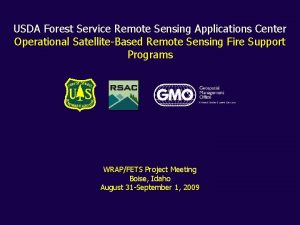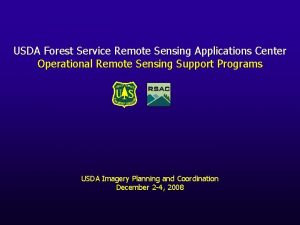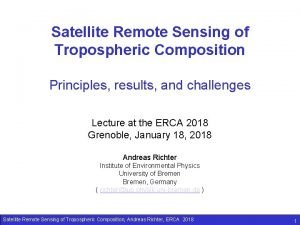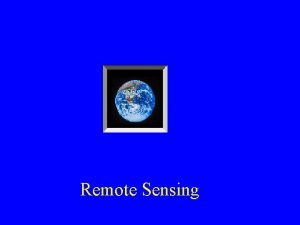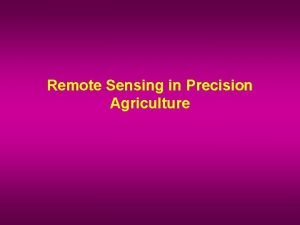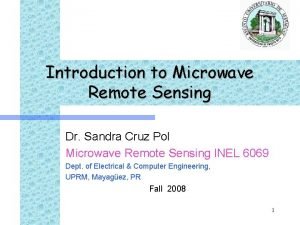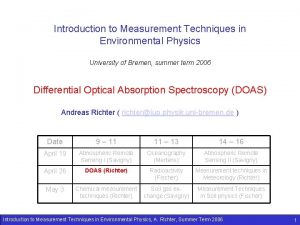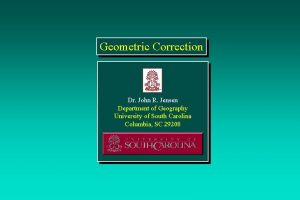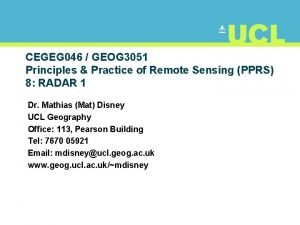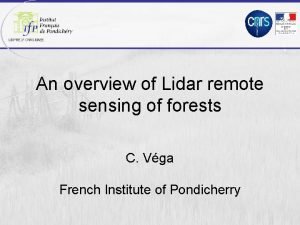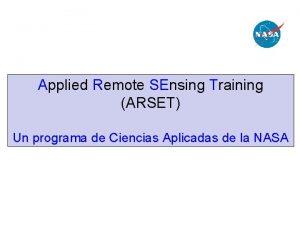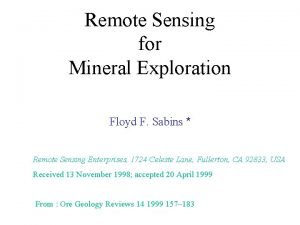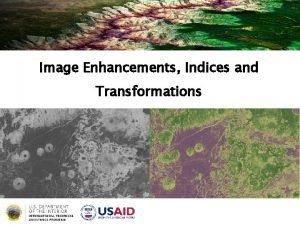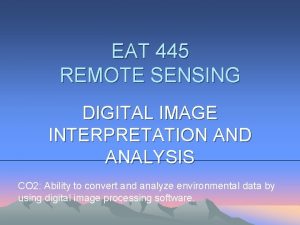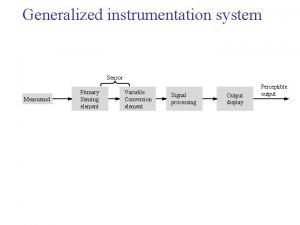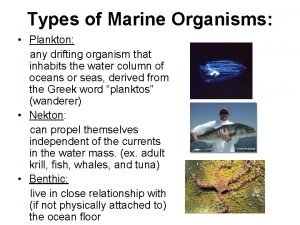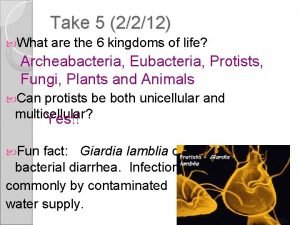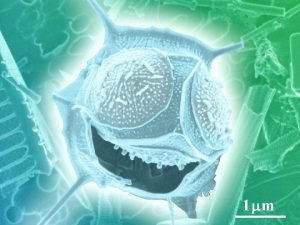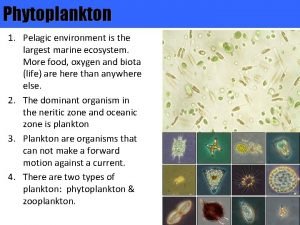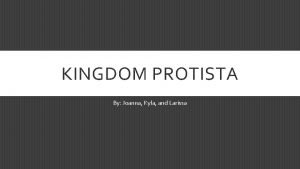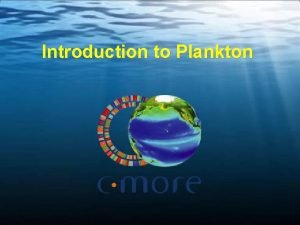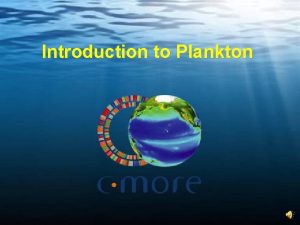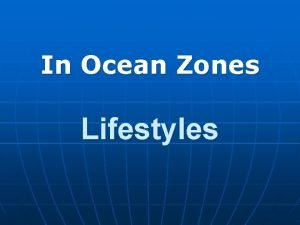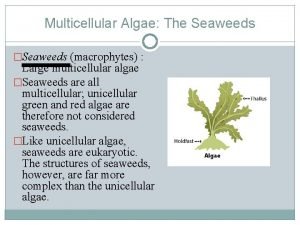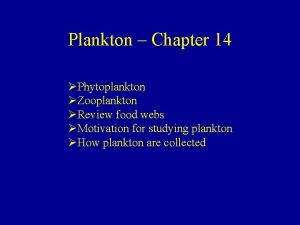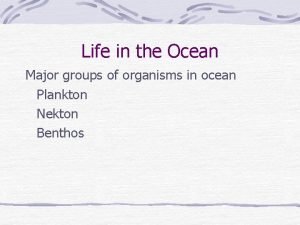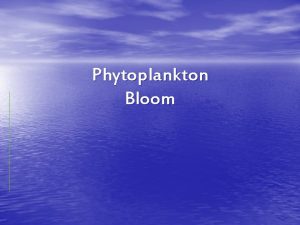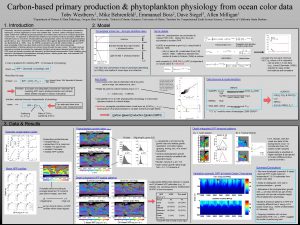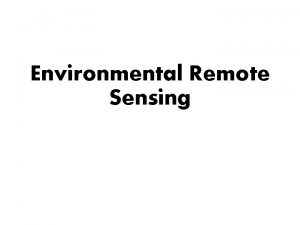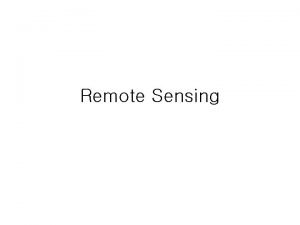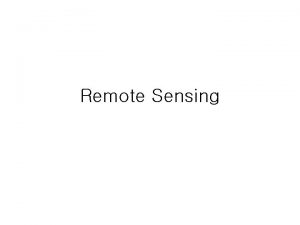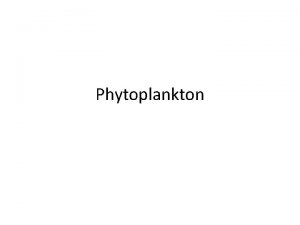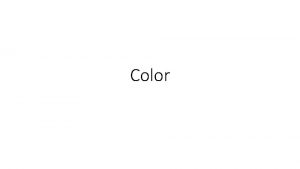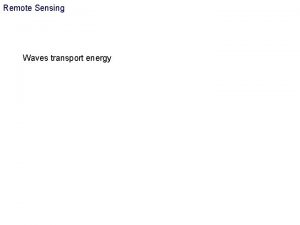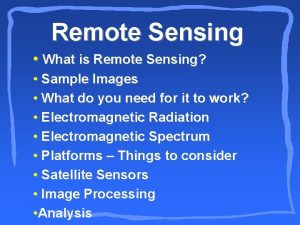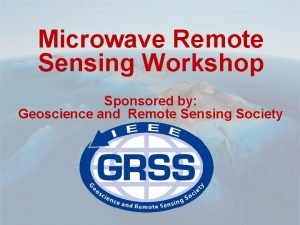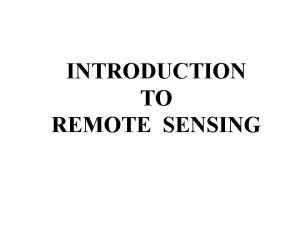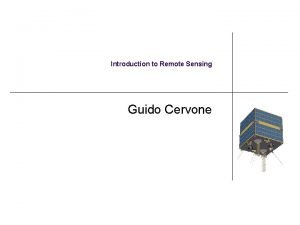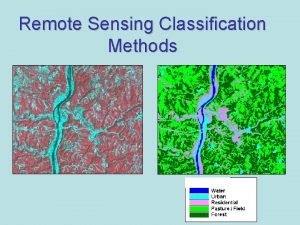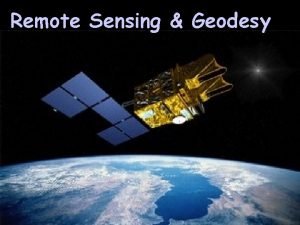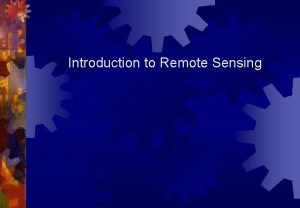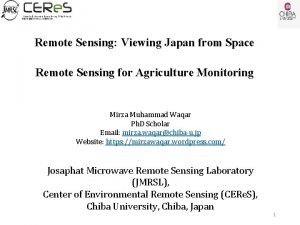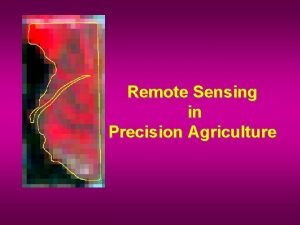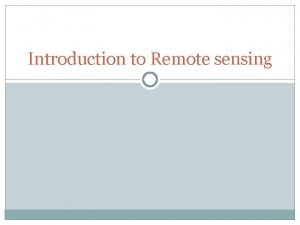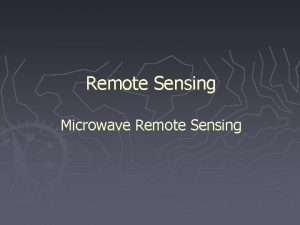Ocean color remote sensing of phytoplankton physiology primary



![Modeling NPP General Chl-based C-based NPP ~ [biomass] x physiologic rate NPP ~ [Chl] Modeling NPP General Chl-based C-based NPP ~ [biomass] x physiologic rate NPP ~ [Chl]](https://slidetodoc.com/presentation_image_h/96ea883f7e7ec37beaf4dacf318af8ab/image-4.jpg)





![Cb. PM overview • Invert ocean color data to estimate [Chl a] & bbp(443) Cb. PM overview • Invert ocean color data to estimate [Chl a] & bbp(443)](https://slidetodoc.com/presentation_image_h/96ea883f7e7ec37beaf4dacf318af8ab/image-10.jpg)




































- Slides: 46

Ocean color remote sensing of phytoplankton physiology & primary production Toby K. Westberry 1, Mike J. Behrenfeld 1 Emmanuel Boss 2, David A. Siegel 3 1 Department of Botany, Oregon State University 2 School of Marine Sciences, University of Maine 3 Institute for Computational Earth System Science, UCSB

Outline 1. Introduction to problem - Phytoplankton Chl v. Carbon - NPP modeling 2. Model - bio-optics - physiology - photoacc. /light limitation/nutrient stress 3. Results - surface & depth patterns - global patterns 4. Validation 5. Future directions

Carbon v. Chlophyll • How to quantify phytoplankton • Historically, net primary production (NPP) has been modeled as a function of chlorophyll concentration • BUT, cellular chlorophyll content is highly variable and is affected by acclimation to light & nutrient stress and species composition Chl is NOT biomass
![Modeling NPP General Chlbased Cbased NPP biomass x physiologic rate NPP Chl Modeling NPP General Chl-based C-based NPP ~ [biomass] x physiologic rate NPP ~ [Chl]](https://slidetodoc.com/presentation_image_h/96ea883f7e7ec37beaf4dacf318af8ab/image-4.jpg)
Modeling NPP General Chl-based C-based NPP ~ [biomass] x physiologic rate NPP ~ [Chl] x Pbopt NPP ~ [C] x m Scattering (cp or bbp) Ratio of Chl to scattering (Chl: C)

Phytoplankton C • Scattering covaries with particle abundance (Stramski & Kiefer, 1991; Bishop, 1999; Babin et al. , 2003) • Scattering also covaries with phytoplankton carbon (Behrenfeld & Boss, 2003; Behrenfeld et al. , 2005) • Chlorophyll variations independent of carbon (C) are an index of changing cellular pigmentation

Scattering: Chl From Behrenfeld & Boss (2003)

75 o 90 o 75 o 60 o NP o 30 15 o 0 o 15 o o 30 15 o CP CA SI NA NP NI 45 o NA 0 o 30 o SP 45 o 60 o 75 o 30 o 28 Regional Bins based on seasonal Chl variance SA 45 o 60 o SO 15 o SA SP L 0 L 1 L 2 L 3 L 4 Chlorophyll Variance Level 60 o 45 o SO-all 75 o 90 o ‘cell size domain? ’ bbp (m-1) ‘biomass domain’ excluded C = (bbp – intercept) x scalar = (bbp – 0. 00035) x 13, 000 1. Chl: C is consistent with lab data Mean Chl: C=0. 010, range=0. 002 -0. 030 (see synthesis in Behrenfeld et al. (2002)) ‘physiology domain’ Chlorophyll (mg m-3) 2. C ~ 25 -40% of POC (Eppley et al. (1992); Du. Rand et al. (2001); Gundersen et al. (2001), Obuelkheir et al. (2005), Loisel et al. , (2001), Stramski et al. , (1999))

Chl: C (mg mg-1) Light (moles photons m -2 h-1) Space Chl: C (mg mg-1) Chl: C Laboratory Chl: C registers physiology Low Nutrient stress High Growth rate (div. d-1) Low Nutrient stress High Temperature ( o. C) after Behrenfeld et al. (2005)

Model
![Cb PM overview Invert ocean color data to estimate Chl a bbp443 Cb. PM overview • Invert ocean color data to estimate [Chl a] & bbp(443)](https://slidetodoc.com/presentation_image_h/96ea883f7e7ec37beaf4dacf318af8ab/image-10.jpg)
Cb. PM overview • Invert ocean color data to estimate [Chl a] & bbp(443) (Garver & Siegel, 1997; Maritorena et al. , 2001) • Relate bbp(443) to carbon biomass (mg C m-3) (Behrenfeld et al. , 2005) • Use Chl: C to infer physiology (photoacclimation & nutrient stress) • Propagate information through water column • Estimate phytoplankton growth rate (m) and NPP Carbon-based Production Model (Cb. PM)

Cb. PM details (1) 2. Let cells photoacclimate through the water column Chl : C -nutrient stress falls off as e-Dz (Dz=distance from nitracline) m (divisions d-1) 1. Let surface values of Chl: C indicate level of nutrient-stress Ig (Ein m-2 h-1)

Cb. PM details (2) 3. Spectral accounting for underwater light field -both irradiance & attenuation Chl : C m (divisions d-1) 4. Phytoplankton growth rate, m Ig (Ein m-2 h-1) Max. growth rate Nutrient limitation (& temperature) Light limitation 5. Net primary production, NPP(z) = m(z) x C(z)

Sea. Wi. FS n. Lw Kd(490) Maritorena et al. (2001) bbp chl C Chl: C NPP PAR(0+) FNMOC WOA 01 MLD NO 3 Austin & Petzold (1986) Kd(l) Morel (1988) Photoacclimation Light limitation INPUTS DNO 3 > 0. 5 m. M Ed(l) PAR(z) m * if z<MLD, * red arrows indicate relationships exist ONLY when z>MLD * Run with 1° x 1° monthly mean climatologies (1999 -2004) zno 3, Dzno 3 DChl: Cnut OUTPUTS

Results

Example profiles (1) Sargasso Sea (35°N, 65°W, Aug) Stratified, shallow mixed layer, oligotrophic MLD =25 m z. NO 3 =110 m zeu =105 m

Example profiles (2) North Atlantic (50°N, 30°W, Apr) Deep mixed layer, nutrient replete MLD =95 m z. NO 3 =0 m zeu =40 m

Example profiles (mean) Depth (m) Annual mean northern hemisphere m NPP Chl mg Chl m-3 - c. f. Morel & Berthon (1989) d-1 mg C m-3 d-1

Surface patterns South Pacific (L 0) (central gyre) Equatorial (L 3) Chl (mg Chl m-3) C (mg C m-3) Chl: C (mg mg-1) South Pacific (L 2) (non-gyre) North Atlantic (L 3) Month # since 1997

Growth rate, m Summer (Jun-Aug) • Persistently elevated in upwelling regions • Chronically depressed in open ocean • Can see effects of mixing depth & micro-nutrient limitation Winter (Dec-Feb) Annual mean (L 0 only) m (d-1)

NPP patterns Summer (Jun-Aug) • O(1) looks like Chl - gyres, upwelling, seasonal blooms Winter (Dec-Feb) ∫NPP (mg C m-2 d-1) • Large seasonal cycle at high latitudes (ex. , N. Atl. )

NPP patterns (2) mg C m-2 d-1 • large spatial (& temporal) differences in carbon-based NPP from chl-based results (e. g. , > ± 50%) • differences due to photo acclimation and nutrient-stress related changes in Chl : C

Seasonal NPP patterns (N. Atl. ) Western N. Atl CBPM VGPM Eastern N. Atl

Seasonal NPP patterns Cb. PM VGPM • seasonal cycles dampened in tropics, but strengthened and delayed in “spring bloom” areas

Annual NPP ∫NPP (Pg C) VGPM This model Annual 45 52 Gyres 5 (11%) 13 (26%) High latitudes 19 (42%) 12 (23%) Subtropics? 18 (39%) 25 (48%) 2 (4%) 3 (5%) Southern Ocean (q<-50°S) • Although total NPP doesn’t change much (~15%), where and when it occurs does

Validation

Surface Chl: C at HOT • Prochlorococcus cellular fluorescence at HOT ~(in situ Chl : C) (Winn et al. , 1995) HOT • Satellite Chl : C 1998 1999 2000 2001 2002

Chl(z) & Kd(z) at BATS Model compared to Bermuda Atlantic Timeseries Study/Bermuda Bio. Optics Project (BATS/BBOP) HPLC Chl & CTD fluorometer

∫NPP (mg C m-2 d-1) ∫NPP at HOT & BATS

NPP (mg C m-3 d-1) NPP(z) at HOT Serial day since 09/1997

NPP(z) at HOT - Uniform mixed layer (step function) v. in situ incubations - Discrepancies due to satellite estimates, NOT concept

Future directions

Next steps (model) • Sensitivity to inputs (e. g. , MLD, MODIS) • Error budget • Inclusion of CDOM(z) • Change photoacclimation with depth • change bbp to C relationship -diatoms, coccolithophorids, coastal • Further validation

Next steps (applications) • Look at finer spatial/temporal scales • Knowledge of m & d. C/dt allow statements about loss processes • Recycling efficiency (wrt nutrients) • Characterization of ocean in terms of nutrient and light limitation patterns • Inclusion of concepts/data into coupled models

Thanks OSU Robert O’Malley Julie Arrington Allen Milligen Giorgio Dall’Olmo Princeton Jorge Sarmiento Patrick Shultz Mike Hiscock UCSB Norm Nelson Stephane Maritorena Manuela Lorenzi-Kayser toby. westberry@science. oregonstate. edu

Extra

Chl: C (mg mg-1) 3 primary factors Chl: Cmax Chl: Cmin Light Dunaliella tertiolecta 20 o. C Replete nutrients Exponential growth phase Light (moles m-2 h-1) Chl: Cmax Geider (1987) New Phytol. 106: 1 -34 Temperature 16 species = Diatoms = all other species Temperature (o. C) Laws & Bannister (1980) Limnol. Oceanogr. 25: 457 -473 Chl: Cmin Laboratory Chl: C physiology Nutrients Thalassiosira fluviatilis = NO 3 limited cultures = NH 4 limited cultures Low Nutrient stress High Growth rate (div. d-1) = PO 4 limited cultures

Depth-resolved CBPM z=0 Uniform z=MLD Nutrient-limited &/or light-limited + photoacclimation z=z. NO 3 Light-limited + photoacclimation Relative PAR Relative NO 3 z=∞ * Iterative such that values at z=zi+1 depend on values at z=zi *

GSM 01 (Maritorena et al. , 2002) • Non-linear least squares problem with 3 unknowns and 5 equations • Solved by minimization of of squared sum of residuals (between obs & estimate) • Result is Chl, acdm(443), bbp(443)

The Model (con’t)

CBPM data sources INPUT (surface) - Sea. Wi. FS: n. Lw(l), PAR, Kd(490) - GSM 01: Chl a, bbp(443) - FNMOC: MLD - WOA 2001: ZNO 3 OUTPUT ( (z)) - Chl, C, & Chl: C - m - NPP Run with 1° x 1° monthly mean climatologies (1999 -2004)

Example profiles (3) Southern Ocean (50°S, 130°W, Aug) Deep winter mixing, Very low light, Nutrient replete MLD =>300 m z. NO 3 =0 m zeu =

Growth rate, m (2) Annual mean m (d-1) Annual mean (L 0 only) m (d-1)

NPP patterns (Jun-Aug) This work • large spatial & temporal differences in carbon-based NPP from Chl-based results (e. g. , > ± 50%) VGPM (Chl-based model) ∫NPP (mg C m-2 d-1) • Chl-based model interprets high Chl areas as high NPP • differences due to photo acclimation and nutrient-stress related changes in Chl : C ∫NPP (mg C m-2 d-1)

NPP patterns (2) mg C m-2 d-1 • large spatial & temporal differences in carbon-based NPP from chl-based results (e. g. , > ± 50%) • seasonal cycles dampened in tropics, but strengthened and delayed in “spring bloom” areas C-based Chl-based • differences due to photo acclimation and nutrient-stress related changes in Chl : C

Annual NPP Annual ∫NPP (Pg C) DMLD CBPM 45 (61) 75 O BY DKd SHOW R SI 8 -10 BA C EAN 26 This model T IST D RE U RIB 52 OW H S O T ON S A E 18 S R O D/ N A N -- DChl O VGPM ? ? N IO 8 ? ? 4 37 29 Models are very sensitive to input sources D∫NPP for change In input

Conclusions • Spectral, depth-resolved NPP model that includes photoacclimation, light & nutrient limitation - based on phytoplankton scattering-carbon relationship • Consistencies with field data ongoing validation • Spatial patterns in ∫PP markedly different than Chl-based models - also different seasonal cycles (timing/magnitude) toby. westberry@science. oregonstate. edu
 N-rays
N-rays Remote sensing platforms
Remote sensing platforms Active passive remote sensing
Active passive remote sensing Limitations of remote sensing
Limitations of remote sensing Digital number remote sensing
Digital number remote sensing Limitations of remote sensing
Limitations of remote sensing Idealized remote sensing system
Idealized remote sensing system Remote sensing ap human geography
Remote sensing ap human geography Aggregation ap human geography
Aggregation ap human geography Parallax in remote sensing
Parallax in remote sensing Strip camera in remote sensing
Strip camera in remote sensing Remote sensing image
Remote sensing image Ifov and fov in remote sensing
Ifov and fov in remote sensing Fiducial axis in aerial photography
Fiducial axis in aerial photography National authority for remote sensing and space sciences
National authority for remote sensing and space sciences Canadian centre for remote sensing
Canadian centre for remote sensing Ap human geography unit 1
Ap human geography unit 1 Remote sensing applications center
Remote sensing applications center Remote sensing applications center
Remote sensing applications center Remote sensing physics
Remote sensing physics Microwave remote sensing lecture notes
Microwave remote sensing lecture notes Remote sensing in precision agriculture
Remote sensing in precision agriculture Aerial photography in remote sensing pdf
Aerial photography in remote sensing pdf Introduction to microwave remote sensing
Introduction to microwave remote sensing Remote sensing physics
Remote sensing physics Geometric corrections
Geometric corrections Cegeg
Cegeg Full waveform lidar
Full waveform lidar Supervised classification
Supervised classification Applied remote sensing training program
Applied remote sensing training program Advantages of remote sensing
Advantages of remote sensing Remote sensing
Remote sensing Digital interpretation in remote sensing
Digital interpretation in remote sensing Primary sensing element example
Primary sensing element example Phytoplankton examples
Phytoplankton examples Kelp (seaweed) is in the ________ kingdom.
Kelp (seaweed) is in the ________ kingdom. Pelagic phytoplankton
Pelagic phytoplankton Pelagic phytoplankton
Pelagic phytoplankton Is phytoplankton a protist
Is phytoplankton a protist What is plant plankton
What is plant plankton Phytoplankton examples
Phytoplankton examples Hadopelagic
Hadopelagic Chlorella is unicellular or multicellular
Chlorella is unicellular or multicellular Multicellular seaweed
Multicellular seaweed Where do you find phytoplankton
Where do you find phytoplankton Meroplankton
Meroplankton Epifuana
Epifuana
